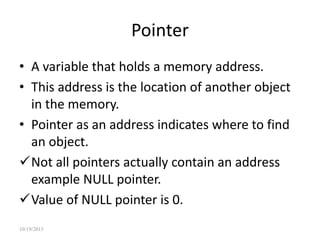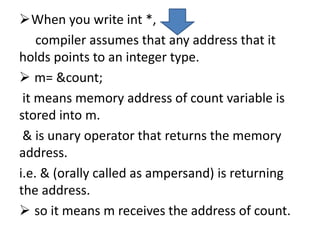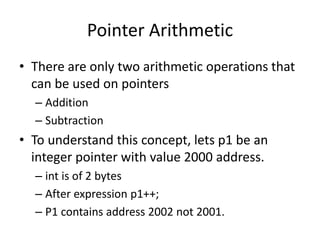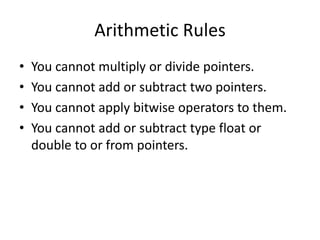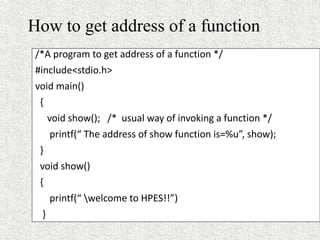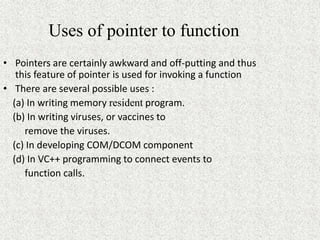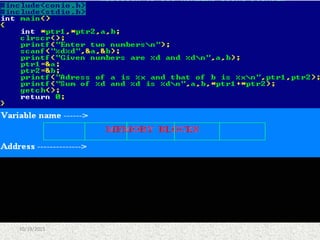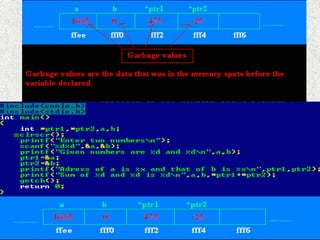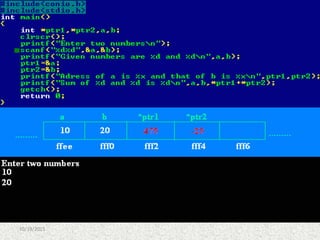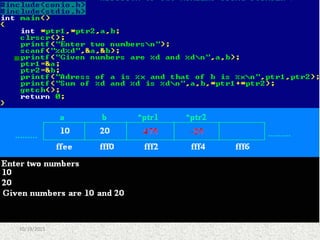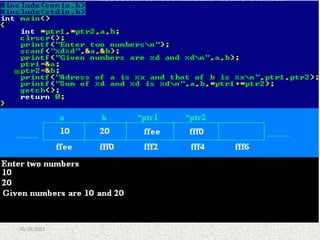Pointers in C Programming
- 1. POINTERS Presented by Er. Jasleen Kaur Assistant Professor Applied Science(CSE) Chandigarh University Gharuan (Mohali).
- 2. Pointer • A variable that holds a memory address. • This address is the location of another object in the memory. • Pointer as an address indicates where to find an object. Not all pointers actually contain an address example NULL pointer. Value of NULL pointer is 0. 10/19/2015
- 3. • Pointer can have three kinds of content in it 1) The address of an object, which can be dereferenced. 2) A NULL pointer. 3) Invalid content, which does not point to an object. (If p does not hold a valid value, it can crash the program) • If p is a pointer to integer, then – Int *p
- 4. It is possible in some environments to have multiple pointer values with different representations that point to same location in memory. But make sure if the memory is deleted using delete or if original variable goes out of scope.
- 5. Declaring pointer Data-type *name; * is a unary operator, also called as indirection operator. Data-type is the type of object which the pointer is pointing. Any type of pointer can point to anywhere in the memory. * is used to declare a pointer and also to dereference a pointer.
- 6. When you write int *, compiler assumes that any address that it holds points to an integer type. m= &count; it means memory address of count variable is stored into m. & is unary operator that returns the memory address. i.e. & (orally called as ampersand) is returning the address. so it means m receives the address of count.
- 7. Suppose, count uses memory Address 2000 to store its value 100. so, m=&count means m has 2000 address. q= *m it returns the value at address m. value at address 2000 is 100. so, q will return value 100. i.e. q receives the value at address m. count=1002000
- 8. Address-of operator(&) • It is used to reference the memory address of a variable. • When we declare a variable, 3 things happen – Computer memory is set aside for variable – Variable name is linked to that location in memory – Value of variable is placed into the memory that was set aside.
- 9. Int *ptr; declaring variable ptr which holds the value at address of int type int val =1; assigning int the literal value of 1 ptr=&val; dereference and get value at address stored in ptr int deref =*ptr printf(“%dn”, deref); Output will be 1
- 10. Pointer Conversions • One type of pointer can be converted to another type of pointer. • int main() { double x=100.1, y; int *p; p= (int *) &x; //explicit type conversion y= *p; }
- 11. Generic Pointer void * pointer is called as generic pointer. Can’t convert void *pointer to another pointer and vice-versa. void *pointer can be assigned to any other type of pointer. void * is used to specify a pointer whose base type is unknown. It is capable of receiving any type of pointer argument without reporting any type of mismatch.
- 12. Pointer Arithmetic • There are only two arithmetic operations that can be used on pointers – Addition – Subtraction • To understand this concept, lets p1 be an integer pointer with value 2000 address. – int is of 2 bytes – After expression p1++; – P1 contains address 2002 not 2001.
- 13. • Each time p1 is incremented, it will point to next integer. • The same is true for decrement. – for p1--; – Causes value of p1 to be 1998. • Each time a pointer is incremented, it points to the memory location of the next element of its base type. • If decremented, then it points to previous element location. • P1=p1+12; makes p1 points to 12th element of p1 type.
- 14. Arithmetic Rules • You cannot multiply or divide pointers. • You cannot add or subtract two pointers. • You cannot apply bitwise operators to them. • You cannot add or subtract type float or double to or from pointers.
- 15. Pointer Comparison • You can compare two pointers in a relational expression, example: if(p<q) printf(“p points to lower memory than q n”); • Pointer comparison are useful only when two pointers point to a common object such as an array.
- 16. Benefits of pointer • Pointers are used in situations when passing actual values is difficult or not desired. • To return more than one value from a function. • They increase the execution speed. • The pointer are more efficient in handling the data types . • Pointers reduce the length and complexity of a program.
- 17. • The use of a pointer array to character string results in saving of data. • To allocate memory and access it( Dynamic memory Allocation). • Implementing linked lists, trees graphs and many other data structure.
- 18. How to get address of a function /*A program to get address of a function */ #include<stdio.h> void main() { void show(); /* usual way of invoking a function */ printf(“ The address of show function is=%u”, show); } void show() { printf(“ welcome to HPES!!”) }
- 19. Uses of pointer to function • Pointers are certainly awkward and off-putting and thus this feature of pointer is used for invoking a function • There are several possible uses : (a) In writing memory resident program. (b) In writing viruses, or vaccines to remove the viruses. (c) In developing COM/DCOM component (d) In VC++ programming to connect events to function calls.
- 20. 10/19/2015
- 21. 10/19/2015
- 22. 10/19/2015
- 23. 10/19/2015
- 24. 10/19/2015
- 25. 10/19/2015


